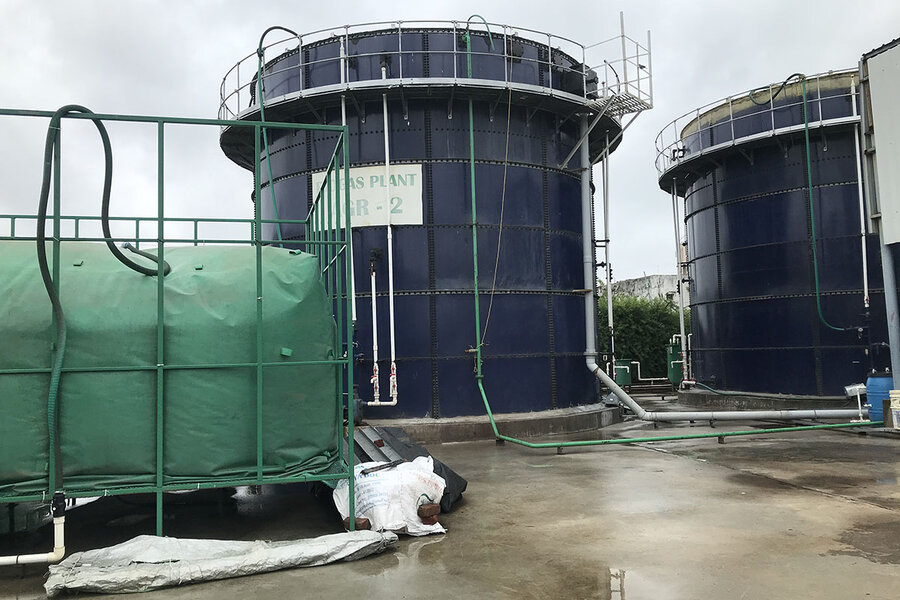Original publication by Kavitha Yarlagadda for csmonitor.com on 13 October 2022

10, 2022. The resulting pulp is passed into an anaerobic digester, which converts the waste into biogas.
Kavitha Yarlagadda
The Bowenpally Vegetable Market in Hyderabad, India, is a hub of activity.
Every day, more than 5,000 traders, shoppers, drivers, and employees pass through the massive market yard, perusing mountains of cabbage and gourd varieties, sneaking by towers of onions, and eyeing baskets of bright red chilis. Small vendors such as Padma Devi come at least once a week, rain or shine, to stock up on produce for their businesses back home.
“Sometimes I sell them within three days, and then I come back for more,” she says.
The bustling ecosystem produces many happy customers – and heaps upon heaps of waste. Of the 1,500 to 2,000 metric tons of produce handled daily at Bowenpally, about 10 metric tons will be left behind.
But for the past couple years, that waste hasn’t lingered. It’s been quietly redirected to the Bowenpally market’s very own compressed biogas (CBG) plant, where organic material is broken down into usable fuel. Instead of going into a landfill, spoiled or otherwise unsellable vegetables are gathered up daily and turned into electricity which powers buildings, streetlights, and a kitchen that prepares meals for hundreds of people, including Ms. Devi.
“I didn’t know that the canteen was powered with waste,” she says, smiling. “It’s something good.”
While no silver bullet, biogas is an increasingly important part of governments’ climate action plans as countries try to move away from coal and fossil fuels. In India, industry groups expect corporations to invest millions in new biogas projects in the coming years. Prime Minister Narendra Modi inaugurated a massive biogas plant in Indore in the state of Madhya Pradesh in February, and just this summer, a CBG plant in Punjab – the largest of its kind in Asia – began producing biogas for commercial sale.
Critics warn that biogas has many limitations, and shouldn’t distract from developing more scalable and permanent climate solutions. But at a local level, the technology offers a convenient way to tackle two environmental problems at once.
“One, it’s a much-needed replacement for fossil fuels,” says Andrew Benedek, founder and CEO of Canadian clean energy company Anaergia. “And second, [biogas] makes use of waste that would otherwise emit the greenhouse gas methane, which is 37% of the climate change problem.”

Kavitha Yarlagadda
Creating energy out of waste
There are millions of biogas plants operating across India, mostly small family plants designed to run on animal manure, but also medium- and large-scale enterprises that utilize food waste, sewage, and other organic matter.
At the Bowenpally market, unsold vegetables are shredded into a pulp and passed into an anaerobic digester, where bacteria eat up the waste and emit methane and carbon dioxide gasses. The gas is then stored in four huge balloons until it can be used. It can directly replace liquefied petroleum gas in certain applications, or be converted to electricity using a combustion engine and generator.
The plant can process 10 to 15 metric tons of waste every day, according to Shruti Ahuja, director and business head at Ahuja Engineering Services, a Hyderabad-based company that installed the plant on a piece of land donated by the government. It uses technology provided by Indian Institute of Chemical Technology, a government research center also based in Hyderabad. “Waste generated in the market yard changes over seasons, so the plant is designed to also handle low amounts of waste,” she says.
The plant generates enough gas and electricity to power the canteen kitchen – which makes 800 meals a day – as well as light the streets and buildings within the market. The Bowenpally Agricultural Market Committee reports that using biogas also helps the market save around $1,800 on its monthly electricity bill.
Not a universal fix
Biogas has its limits. Researchers say technological advancement is needed to streamline biogas production and make the relatively delicate process more scalable for a large population. As it stands, changes in plant temperature and input material can pose challenges.
“A minor change would be acceptable by the biological system, but if there is a drastic change … the system will have to be cleaned and started again, which takes time,” says Sydney Lobo, a Mumbai-based international consultant in the clean technology space. “This is the biggest limitation.”
There’s also the issue of obtaining the waste.
Biogas plants are less effective in urban settings, where organic waste may be plentiful, but costly to separate from other trash. India’s poor waste management record exacerbates this challenge, though it’s not necessarily insurmountable. Hopes are high for the plant Mr. Modi inaugurated earlier this year, for example, because Indore consistently ranks as one of India’s cleanest cities and already has a segregated waste system.
Wide-ranging benefits
Yet where biogas plants are being established, the potential is great.
Experts say CBG can serve three critical needs of the growing economy: cooking, industrial energy, and transportation.
It also eases burdens on landfills, and produces a fertilizer known as “digestate.” While biogas is considered as the primary product, this nutrient-rich byproduct can serve as a valuable soil conditioner for farmers.
“If the potential is realized, biogas use can accrue additional wide-ranging benefits including emission reduction, improved public health, reduced use of chemical fertilizers, savings in fertilizer subsidies, and improved soil nutrition,” says Disha Agarwal, a program lead at the Council on Energy, Environment and Water in New Delhi.
But for many at the Bowenpally Vegetable Market, there’s a simple comfort in knowing that their garbage is getting a second life.
S. Madhu makes monthly trips to the market, bearing farmers’ crops from his village in the neighboring state of Karnataka. At the end of the day, he and other traders often abandon unsold stock to save on transportation costs.
“I am happy that the spoiled and excess vegetables we leave behind are being recycled and converted to something useful,” says Mr. Madhu.




